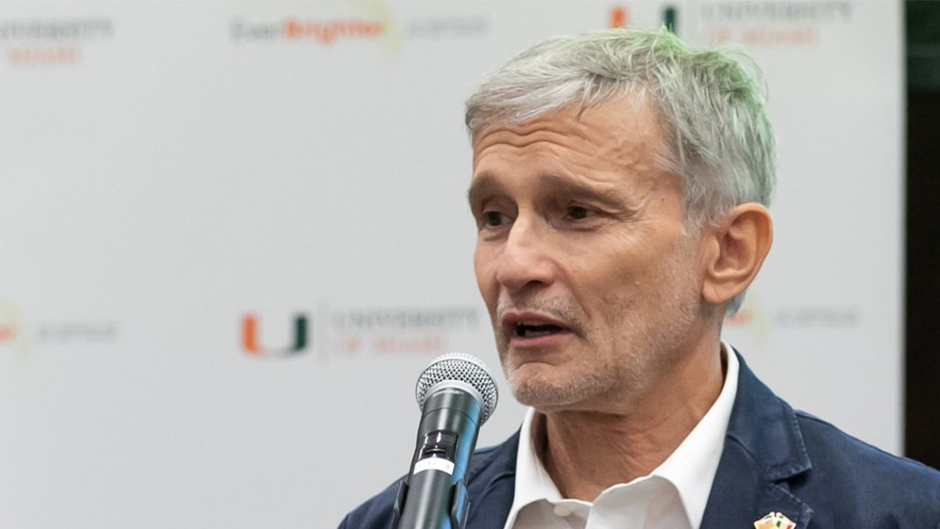Antonio Nanni, Ph.D. ’85, P.E., professor and chair, Department of Civil & Architectural Engineering, will be honored on April 11 with the 2023 Faculty Senate Distinguished Faculty Scholar Award in recognition of his lasting contributions to the field of concrete.
“A big congratulations to Tony, as this is the highest award the University offers to its faculty in research,” said Pratim Biswas, dean of the College of Engineering. “As a renowned innovator and industry leader, he has helped develop new materials, applications, and standards for boosting sustainability in one of the world’s oldest construction sectors.”
Prior to receiving the Faculty Scholar award, Nanni will become 2023-2024 president of the American Concrete Institute (ACI), the largest technical organization in the world devoted to concrete, with 30,000 members in 52 worldwide chapters. “I look forward to the opportunity to advance sustainability in concrete construction during my term as the 100th President,” said Nanni, who will take office on April 6 at the ACI’s annual convention in San Francisco.
An innovative approach
Since graduating with a PhD from the College of Engineering more than 35 years ago, Nanni has taken an innovative approach to civil engineering, finding new solutions for long-time challenges. For instance, he has led the research and development of composite materials, such as fiber-reinforced polymer (FRP), to strengthen concrete structures instead of traditional metal rebar.
“Most of my research is on the applied side,” he said, “At the College of Engineering, we want to move technology from the laboratory to the field, translating innovation into applications.” For instance, Nanni has demonstrated the safe utilization of seawater and salt-contaminated aggregates for concrete production combined with noncorrosive reinforcement. This technology is now being considered for infrastructure reconstruction in disaster-impacted Caribbean islands, as well as Latin American countries.
In the past decade, Nanni has received more than a dozen industry honors, including the ACI Foundation’s Arthur J. Boase Award in 2021; “Innovation Bridge” Grand Conceptor Award, from The American Council of Engineering Companies of Florida in 2018; and the ACI’s Joe W. Kelly Award for outstanding contributions to education in the broad field of concrete in 2018. In addition, he has written or co-authored nearly 300 journal articles, contributed to 24 books or book chapters and made more than 400 presentations to academic and industry organizations.
Nanni has also been a leader in professional and standard-writing agencies, paving the way for the worldwide adoption of composite materials. “Unless new technologies are included into standards, they cannot be widely adopted,” said Fabrice Manns, Ph.D., professor and chair, Department of Biomedical Engineering, in nominating Nanni for the award. “Tony has been the driving force or the lead author in many of the documents in the area of composite reinforcement or structural assessment.”
Leadership in composite materials
After earning his doctorate at the University of Miami, Nanni spent three years at the College of Engineering as an assistant professor. He then taught at the Pennsylvania State University and University of Missouri-Rolla before returning to the University of Miami in 2006. After studying FRP reinforcement for new and existing concrete structures in the early 1990s, Nanni urged the ACI to form a new technical committee. This led to a new “Emerging Technology Series” from the ACI that has contributed to the dramatic growth of the FRP repair and reinforcing sector throughout North America and beyond.
While on sabbatical in Italy in 1996, Nanni developed his second technical passion: in-situ load testing of existing structures, beginning research on a new “cyclic load test.” The following year, he tested this uncharted concept by assessing the capacity of a parking garage slab in Atlanta. The merits of this work led to Nanni being recognized as one of the “Top 25 Newsmakers in Construction” by Engineering News-Record. Today, the ACI code requirements incorporate the cyclic load test standard.
With his professional engineering seal, Nanni has contributed to many notable U.S. repair projects using composite strengthening, including Pittsburgh International Airport’s parking garage and the Oklahoma City Myriad Convention Center in 1997. Three of these concrete repair projects received awards from the International Concrete Repair Institute, including the 2020 “Repair Project of the Year.”
Advancing civil engineering at the University
In 2009, Nanni founded the Center for the Integration of Composites into Infrastructure, a multicenter Industry/University Cooperative Research Center (I/UCRC) at the University, funded by the National Science Foundation through 2024. The center now receives more than $250,000 annually from industry members to conduct research that is beneficial to the entire composite industry. “While there are more than 50 I/UCRC centers around the country, this may be the only one related to composites in construction,” said Nanni.
“As designated engineer, Tony has led the way in other leading-edge projects, such as a pedestrian bridge, a marine dock, and two buildings constructed without a single pound of ‘black’ steel reinforcement,” said Manns. “These applications are the first attempts in the nation and most likely worldwide to solve the problem of corrosion by completely replacing mild and prestressed steel with FRP bars and tendons.”
In the last three years, Nanni he has worked on other high-impact projects, such as the use of mild-prestressing for glass-FRP bars for the piles of two bridges. With colleagues in his department, he is also contributing to the development of a shoreline protection system with adaptive features for an eco-friendly environment for marine life. Three demonstration projects with non-corrosive reinforcements have been permitted along South Florida’s coastline as seawalls and submerged artificial reefs.
In addition, Nanni recently received an international patent as the lead co-inventor of a new type of composite strand. “Along with being economical, it can be tensioned with conventional chucks, thus removing the most critical barrier to adoption in precast plans,” said Manns.
Reflecting on his contributions to composite research and development, Nanni said, “I believe that noncorrosive reinforcement offers a valuable opportunity for cement manufacturers to reduce their carbon footprints and commercialize alternative products. The future for the concrete industry is brighter than ever.”






